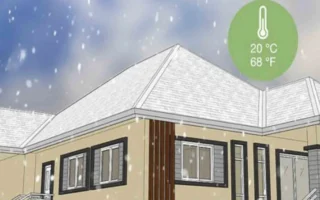When it comes to modern plumbing materials, there are several options available, each with its own set of pros and cons. Traditional materials like copper and CPVC have been used for decades, but PEX has quickly gained popularity due to its unique features and benefits.
What is PEX Plumbing?
PEX, short for cross-linked polyethylene, is a type of flexible plastic tubing used for plumbing and heating systems. It’s made by cross-linking polyethylene molecules, creating a stronger and more durable material than standard polyethylene. PEX tubing is available in various sizes and colors, making it easy to identify different water lines during installation.
Why Choose PEX for Home Plumbing?
There are several reasons why PEX has become a go-to choice for home plumbing:
- Flexibility: PEX tubing is highly flexible, allowing for easier installation and fewer fittings.
- Resistance: It’s resistant to corrosion, scale, and chemicals, ensuring a longer lifespan.
- Cost-effectiveness: PEX is often more affordable than traditional materials, both in terms of materials and labor.
- Durability: With proper installation and maintenance, PEX can last for decades.
Now that we’ve covered the basics, let’s dive deeper into PEX plumbing and explore how to use it in your home.
What Is PEX Plumbing?

As mentioned earlier, PEX is a type of flexible plastic tubing used for plumbing and heating systems. But what exactly makes it different from other materials? Let’s take a closer look.
Definition and Explanation of PEX (Cross-Linked Polyethylene)
PEX is created by cross-linking polyethylene molecules, forming a three-dimensional network of polymer chains. This cross-linking process enhances the material’s strength, flexibility, and resistance to various factors. PEX tubing is typically produced in long coils, making it easy to transport and Install.
Key Features of PEX Tubing
Some of the key features that set PEX apart from other plumbing materials include:
- Flexibility: PEX can be bent and routed around obstacles without the need for additional fittings.
- Resistance: It’s resistant to corrosion, scale, and chemicals, ensuring a longer lifespan.
- Durability: PEX can withstand high temperatures and pressures, making it suitable for both hot and cold water lines.
- Noise reduction: PEX tubing is quieter than metal pipes, reducing water flow noise.
Comparison with Traditional Plumbing Materials (Copper, CPVC)
While copper and CPVC have been widely used for plumbing system, PEX offers several advantages:
- Ease of installation: PEX is more flexible and requires fewer fittings, making installation quicker and easier.
- Cost: PEX is often more affordable than copper, both in terms of materials and labor.
- Corrosion resistance: Unlike copper, PEX doesn’t corrode over time, reducing the risk of leaks and damage.
- Freeze resistance: PEX can expand and contract without bursting, making it more resistant to freezing temperatures.
Now that we have a better understanding of PEX and its benefits, let’s explore how to use it for your home plumbing guide.
Benefits of Using PEX for Home Plumbing

Using PEX for your home plumbing system offers numerous advantages. Let’s take a closer look at some of the key benefits:
Flexibility and Ease of Installation
One of the most significant advantages of PEX is its flexibility. Unlike rigid materials like copper, PEX can be bent and routed around obstacles without the need for additional fittings. This makes installation much easier and faster, saving you time and money on labor costs.
Resistance to Corrosion and Scale
PEX is highly resistant to corrosion and scale buildup, unlike copper. This resistance helps extend the lifespan of your plumbing tips and reduces the risk of leaks and damage.
Cost-Effectiveness in Materials and Labor
PEX is often more affordable than traditional materials like copper, both in material costs and installation labor. The flexibility of PEX and the need for fewer fittings can significantly reduce installation time and costs.
Durability and Longevity
With proper installation and maintenance, PEX can last for decades. It’s resistant to high temperatures and pressures, making it suitable for both hot and cold water lines. PEX’s durability and longevity make it an excellent choice for home plumbing systems.
Fewer Fittings and Joints
Because PEX is so flexible, it requires fewer fittings and joints compared to rigid materials. This not only makes installation easier but also reduces the risk of leaks at joints and fittings.
Freeze Resistance
PEX has a unique ability to expand and contract without bursting, making it more resistant to freezing temperatures. This can be a significant advantage in colder climates where freezing pipes are a common concern.
Now that we’ve explored the benefits of using PEX for home plumbing fixture, let’s move on to the tools and materials you’ll need for installation.
Tools and Materials Needed for PEX Plumbing

To successfully Install a PEX plumbing system in your modern home, you’ll need a few essential tools and materials. Let’s break them down:
Essential Tools
- PEX cutter: A specialized tool designed for cutting PEX tubing cleanly and efficiently.
- Crimp tool: Used for securing PEX tubing to fittings using crimp rings.
- Expansion tool: Used for expanding PEX-A tubing to fit over expansion fittings.
- Clamps: An alternative to crimp rings for securing PEX tubing to fittings.
Types of PEX Tubing (PEX-A, PEX-B, PEX-C) and Their Differences
PEX tubing is available in three main types: PEX-A, PEX-B, and PEX-C. Each type has its own unique characteristics:
- PEX-A: The most flexible type of PEX, suitable for expansion fittings.
- PEX-B: Less flexible than PEX-A but still suitable for most residential applications.
- PEX-C: The least flexible type of PEX, often used for cold water lines.
Fittings and Connectors for PEX Systems
PEX plumbing systems require specialized fittings and connectors to join the tubing to fixtures and other pipes. Common types include:
- Crimp fittings: Used with PEX-B and PEX-C tubing and secured with crimp rings.
- Clamp fittings: An alternative to crimp fittings, secured with clamps.
- Expansion fittings: Used with PEX-A tubing and secured by expanding the tubing over the fitting.
Additional Materials
In addition to the essential tools and PEX tubing, you’ll need a few other materials for a successful installation:
- Manifolds: Used to distribute water to multiple lines in a PEX system.
- Clamps: Used to secure PEX tubing to walls and other surfaces.
- Mounting brackets: Used to support PEX tubing and manifolds during installation.
Now that we’ve covered the tools and materials needed for PEX plumbing, let’s move on to planning your system.
Planning Your PEX Plumbing System

Before you start installing your PEX plumbing system, carefully plan your project. Here are some key steps to consider:
Assessing Your Home’s Plumbing Needs
Start by assessing your home’s plumbing needs. Consider factors such as the number of fixtures, the distance between them, and the required water pressure. This will help you determine the size and layout of your PEX system.
Creating a Plumbing Layout plan
Once you’ve assessed your needs, create a detailed plumbing layout plan. This should include the location of all fixtures, the routing of PEX tubing, and the placement of manifolds and other components. A well-planned layout will make installation easier and more home efficient.
Determining Pipe Sizes and System Zones
Based on your plumbing needs and layout plan, determine the appropriate pipe sizes for your PEX system. You may need to use different sizes for different zones of your home, depending on the water flow requirements. Consult a professional if you’re unsure which pipe sizes are best for your home system.




